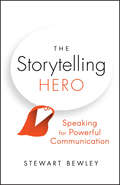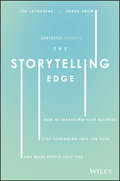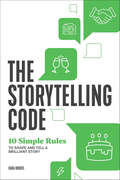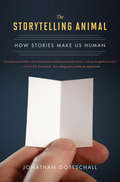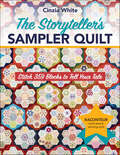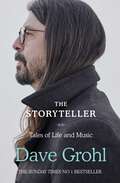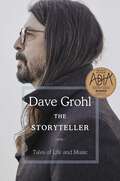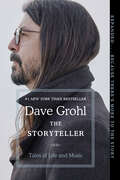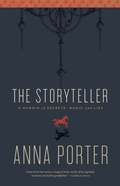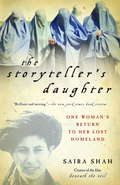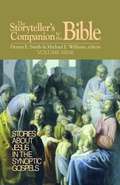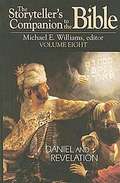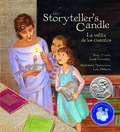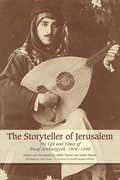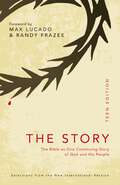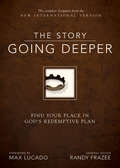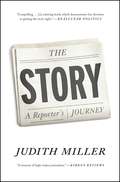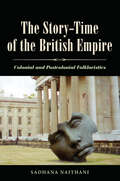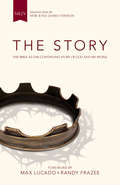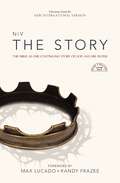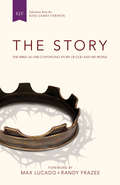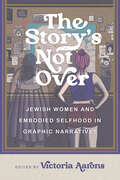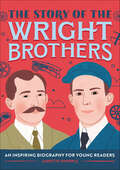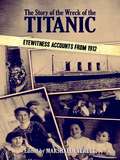- Table View
- List View
The Storytelling Hero: Speaking for Powerful Communication
by Stewart Bewley"Full of practical steps that everyone can use to become a compelling storyteller."—Steve Pierce, Deputy Managing Director and Chief HR Oficer, Hitachi, Europe "Raw and actionable, but with a dreamer's heart, 'The Storytelling Hero' helps even the most reluctant presenter find their voice, while Stew Bewley weaves through his own story to help us think carefully about message and motivation, humanity and heroes."—Aimee Riordan, Senior Communications Manager and reader, writer, storyteller at Microsoft Make your next speech one to remember With expert guidance from veteran public speaking coach Stewart Bewley, you'll discover how to gain the confidence needed to become a phenomenal public speaker. Using simple tools and techniques you can apply every time you speak to a group or an individual, The Storytelling Hero will show you how to: Eliminate self-limiting beliefs that hold you back Find the confidence you need to command a room Establish a memorable and impressive presence Improve your cadence, rhythm and style Connect with your next audience Transform your ability to communicate your ideas, capture attention, and make a positive impression. The Storytelling Hero shows you how to hold an audience in the palm of your hand, one actionable step at a time.
The Storytelling Edge: How to Transform Your Business, Stop Screaming into the Void, and Make People Love You
by Shane Snow Joe Lazauskas Inc. ContentlyTransform your business through the power of storytelling. Content strategists Joe Lazauskas and Shane Snow offer an insider’s guide to transforming your business—and all the relationships that matter to it—through the art and science of telling great stories. Smart businesses today understand the need to use stories to better connect with the people they care about. But few know how to do it well. In The Storytelling Edge, the strategy minds behind Contently, the world renowned content marketing technology company, reveal their secrets that have helped award-winning brands to build relationships with millions of advocates and customers. Join as they dive into the neuroscience of storytelling, the elements of powerful stories, and methodologies to grow businesses through engaging and accountable content. With The Storytelling Edge you will discover how leaders and workers can craft the powerful stories that not only build brands and engage customers, but also build relationships and make people care—in work and in life.
The Storytelling Code: 10 Simple Rules to Shape and Tell a Brilliant Story
by Dana NorrisUnlock the tales within you—unleash the power of storytellingEveryone loves a good story—but how do you turn a fun anecdote into one for the books? Whether you're hoping to impress others during a job interview, trying out stand-up, or giving a hilarious wedding speech, The Storytelling Code provides step-by-step help on crafting your narrative, as well as simple exercises to put those public speaking skills into practice.Master the art of storytelling using 10 easy-to-follow rules to help you shape your story and share it confidently. Humorous advice will give you the courage to tell stories in your everyday life, and the unique exercises will demonstrate how to set a goal for each tale, gather the best materials, keep your audience engaged, and more.The Storytelling Code includes:Tell-tale heart—Release your inner storyteller using 10 easy-to-follow rules, including advice for identifying a narrative goal, shaping a plot, and more.Gift of gab—Find the confidence to go live through courage-building tips that make sure you're capturing and connecting with your audience.Pen to paper—Get those creative writing juices flowing with fill-in writing prompts and insightful checklists to prep you for everyday storytelling situations.Make every story mic drop-worthy with The Storytelling Code.
The Storytelling Animal: How Stories Make Us Human
by Jonathan Gottschall&“Insightful...draws from disparate corners of history and science to celebrate our compulsion to storify everything around us.&”—The New York Times Book Review Humans live in landscapes of make-believe. We spin fantasies. We devour novels, films, and plays. Even sporting events and criminal trials unfold as narratives. Yet the world of story has remained an undiscovered and unmapped country. It&’s easy to say that humans are &“wired&” for story, but why? In this delightful, original book, Jonathan Gottschall offers the first unified theory of storytelling. He argues that stories help us navigate life&’s complex social problems—just as flight simulators prepare pilots for difficult situations. Storytelling has evolved, like other behaviors, to ensure our survival. Drawing on the latest research in neuroscience, psychology, and evolutionary biology, Gottschall tells us what it means to be a storytelling animal. Did you know that the more absorbed you are in a story, the more it changes your behavior? That all children act out the same kinds of stories, whether they grow up in a slum or a suburb? That people who read more fiction are more empathetic? Of course, our story instinct has a darker side. It makes us vulnerable to conspiracy theories, advertisements, and narratives about ourselves that are more &“truthy&” than true. National myths can also be terribly dangerous: Hitler&’s ambitions were partly fueled by a story. But as Gottschall shows, stories can also powerfully change the world for the better. We know we are master shapers of story. The Storytelling Animal finally reveals how stories shape us. &“Lively.&”—San Francisco Chronicle &“Absorbing.&”—Minneapolis Star Tribune &“One of my favorite evolutionary psych writers—always insightful and witty.&”—Steven Pinker
The Storyteller’s Sampler Quilt: Stitch 359 Blocks to Tell Your Tale
by Cinzia WhiteRaconteur—The Storyteller’s Collection, a multi-award-winning quilt, is your next take-anywhere project. Sew a collection of miniature pieced hexagons from Cinzia White’s storytelling sampler. Make the king-size quilt your next long-term project, or pick and choose from 359 block designs to make a project of any size! A mix of hand-stitched and machine-pieced 2 ¼” blocks are organized in 59 collections. Full-size foundation paper patterns are included for many of the blocks, with some helpful notes on English paper piecing. It’s perfect for traditional quilters, fans of Dear Jane, and scrap addicts! 359 pieced hexagons! Raconteur, Cinzia White’s award-winning quilt, is the ultimate block-a-day sampler Finish a challenging king-size quilt, or opt for a more manageable size Try foundation-pieced blocks, English paper piecing, or simply sew it all by hand
The Storyteller: Tales of Life and Music
by Dave GrohlSo, I’ve written a book. Having entertained the idea for years, and even offered a few questionable opportunities (‘It’s a piece of cake! Just do four hours of interviews, find someone else to write it, put your face on the cover, and voila!’), I have decided to write these stories just as I have always done, in my own hand. The joy that I have felt from chronicling these tales is not unlike listening back to a song that I’ve recorded and can’t wait to share with the world, or reading a primitive journal entry from a stained notebook, or even hearing my voice bounce between the Kiss posters on my wall as a child. <p><p> This certainly doesn’t mean that I’m quitting my day job, but it does give me a place to shed a little light on what it’s like to be a kid from Springfield, Virginia, walking through life while living out the crazy dreams I had as young musician. From hitting the road with Scream at 18 years old, to my time in Nirvana and the Foo Fighters, jamming with Iggy Pop or playing at the Academy Awards or dancing with AC/DC and the Preservation Hall Jazz Band, drumming for Tom Petty or meeting Sir Paul McCartney at Royal Albert Hall, bedtime stories with Joan Jett or a chance meeting with Little Richard, to flying halfway around the world for one epic night with my daughters…the list goes on. I look forward to focusing the lens through which I see these memories a little sharper for you with much excitement.
The Storyteller: Tales of Life and Music
by Dave GrohlSo, I&’ve written a book. Having entertained the idea for years, and even offered a few questionable opportunities (&‘It&’s a piece of cake! Just do four hours of interviews, find someone else to write it, put your face on the cover, and voila!&’), I have decided to write these stories just as I have always done, in my own hand. The joy that I have felt from chronicling these tales is not unlike listening back to a song that I&’ve recorded and can&’t wait to share with the world, or reading a primitive journal entry from a stained notebook, or even hearing my voice bounce between the Kiss posters on my wall as a child. This certainly doesn&’t mean that I&’m quitting my day job, but it does give me a place to shed a little light on what it&’s like to be a kid from Springfield, Virginia, walking through life while living out the crazy dreams I had as young musician. From hitting the road with Scream at 18 years old, to my time in Nirvana and the Foo Fighters, jamming with Iggy Pop or playing at the Academy Awards or dancing with AC/DC and the Preservation Hall Jazz Band, drumming for Tom Petty or meeting Sir Paul McCartney at Royal Albert Hall, bedtime stories with Joan Jett or a chance meeting with Little Richard, to flying halfway around the world for one epic night with my daughters…the list goes on. I look forward to focusing the lens through which I see these memories a little sharper for you with much excitement.
The Storyteller: Tales of Life and Music
by Dave GrohlSo, I've written a book. <p><p> Having entertained the idea for years, and even offered a few questionable opportunities ("It's a piece of cake! Just do 4 hours of interviews, find someone else to write it, put your face on the cover, and voila!") I have decided to write these stories just as I have always done, in my own hand. The joy that I have felt from chronicling these tales is not unlike listening back to a song that I've recorded and can't wait to share with the world, or reading a primitive journal entry from a stained notebook, or even hearing my voice bounce between the Kiss posters on my wall as a child. <p><p> This certainly doesn't mean that I'm quitting my day job, but it does give me a place to shed a little light on what it's like to be a kid from Springfield, Virginia, walking through life while living out the crazy dreams I had as young musician. From hitting the road with Scream at 18 years old, to my time in Nirvana and the Foo Fighters, jamming with Iggy Pop or playing at the Academy Awards or dancing with AC/DC and the Preservation Hall Jazz Band, drumming for Tom Petty or meeting Sir Paul McCartney at Royal Albert Hall, bedtime stories with Joan Jett or a chance meeting with Little Richard, to flying halfway around the world for one epic night with my daughters…the list goes on. I look forward to focusing the lens through which I see these memories a little sharper for you with much excitement. <p> <b>New York Times Bestseller</b>
The Storyteller: Memory, Secrets, Magic and Lies
by Anna PorterThis book is the story of one woman's childhood in Hungary.
The Storyteller: A Memoir of Secrets, Magic and Lies
by Anne PorterAs a child growing up in the once-beautiful city of Budapest, Anna Porter's grandfather told her stories of heroes and strife and survival, some as old as the Carpathian basin, some still holding the sting of recent war and hardship. <P><P>Some were fanciful, most were true, and all gave her a personal sense of history, both national and familial. This compulsively readable saga blends one family's story with that of its homeland during one of the 20th century's most tumultuous periods.
The Storyteller's Daughter
by Saira ShahAfter a childhood in rural Kent spent listening to her father's stories of a magical and exotic Afghanistan, Saira Shah set out to discover this wonderful, shattered land for herself. The truths she learned about the people she belonged to and about herself shocked the westerner she is, yet spoke to the eastern woman she was never allowed to be.
The Storyteller's Companion to the Bible Volume 9
by Michael E. Williamssubscription item for Ministry Matters
The Storyteller's Companion to the Bible Volume 8: Daniel and Revelation
by Michael E. Williams Rick Lowery Fred A. ShawThe stories in Daniel and Revelation are among the most vivid in the Bible, but they are also among the most misunderstood. In The Storyteller's Companion to the Bible Volume 8, commentator Rick Lowery and storytellers Michael E. Willliams and Fred A. Shaw show how the symbolism and imagery of these biblical stories offer comfort in times of distress and encouragement to hold fast in faith.
The Storyteller's Candle / La velita de los cuentos: La Velita De Los Cuentos
by Lucia GonzalezPura Belpré Author Award Honor - American Library Association (ALA) Pura Belpré Illustrator Award Honor - American Library Association (ALA)Bilingual English/Spanish. A bilingual biography of Pura Belpré, New York City's first Latina librarian.The winter of 1929 feels especially cold to cousins Hildamar and Santiago--they arrived in New York City from sunny Puerto Rico only months before. Their island home feels very far away indeed, especially with Three Kings' Day rapidly approaching. But then a magical thing happened. A visitor appears in their class, a gifted storyteller and librarian by the name of Pura Belpré. She opens the children's eyes to the public library and its potential to be the living, breathing heart of the community. The library, after all, belongs to everyone--whether you speak Spanish, English, or both. The award-winning team of Lucía González and Lulu Delacre have crafted an homage to Pura Belpré, New York City's first Latina librarian. Through her vision and dedication, the warmth of Puerto Rico came to the island of Manhattan in a most unexpected way.
The Storyteller of Jerusalem: The Life and Times of Wasif Jawhariyyeh, 1904-1948
by Salim Tamari Rachel Beckles Willson Nada Elzeer Issam NassarThe memoirs of Wasif Jawhariyyeh are a remarkable treasure trove of writings on the life, culture, music, and history of Jerusalem. Spanning over four decades, from 1904 to 1948, they cover a period of enormous and turbulent change in Jerusalem's history, but change lived and recalled from the daily vantage point of the street storyteller. Oud player, music lover and ethnographer, poet, collector, partygoer, satirist, civil servant, local historian, devoted son, husband, father, and person of faith, Wasif viewed the life of his city through multiple roles and lenses. The result is a vibrant, unpredictable, sprawling collection of anecdotes, observations, and yearnings as varied as the city itself.Reflecting the times of Ottoman rule, the British mandate, and the run-up to the founding of the state of Israel, The Storyteller of Jerusalem offers intimate glimpses of people and events, and of forces promoting confined, divisive ethnic and sectarian identities. Yet, through his passionate immersion in the life of the city, Wasif reveals the communitarian ethos that runs so powerfully through Jerusalem's past. And that offers perhaps the best hope for its future.
The Story: The Bible as One Continuing Story of God and His People
by Zondervan“The Greatest Story Ever Told” is more than just a cliché. God has gone to great lengths to rescue lost and hurting people. That is what The Story for Teens is all about—the story of the Bible, God’s great love affair with humanity. Condensed into 31 accessible chapters, The Story for Teens sweeps you into the unfolding progression of Bible characters and events from Genesis to Revelation. Using the clear, accurate, and easy-to-understand text of the New International Version, it allows the stories, poems, and teachings of the Bible to read like a novel. And like any good story, it is filled with intrigue, drama, conflict, romance, and redemption. Features: • The story of the Bible … in its own words • Events, characters, and teachings of the Bible arranged chronologically • New International Version text
The Story: Find Your Place in God's Redemptive Plan
by Max Lucado Randy FrazeeHow do you live out God’s redemptive story in everyday life? It can seem hard to do – how to first connect the pieces and stories of the Bible with your life and then to apply them and live them out through your actions, words, and thoughts. Yet your life is connected to every other story in history and the God who loves you. The Story: Going Deeper reveals this connection through insights into the Bible’s stories about God and his people. Pick up this NIV Bible today, and discover how the sweeping saga of God’s redemptive story transforms your story.
The Story: A Reporter's Journey
by Judith MillerStar reporter for the New York Times, the world's most powerful newspaper; foreign correspondent in some of the most dangerous fields; Pulitzer winner; longest jailed correspondent for protecting her sources, Judith Miller is highly respected and controversial. In this memoir, she turns her reporting skills on herself with the intensity of her professional vocation.Judy Miller grew up near the Nevada atomic proving ground. She got a job at the New York Times after a suit by women employees about discrimination at the paper and went on to cover national politics, head the paper's bureau in Cairo, and serve as deputy editor in Paris and then deputy at the powerful Washington bureau. She reported on terrorism and the rise of fanatical Islam in the Middle East and on secret biological weapons plants and programs in Iraq, Iran, and Russia. She covered an administration traumatized by 9/11 and an anthrax attack three weeks later. Miller shared a Pulitzer for her reporting. She turns her journalistic skills on herself and her controversial reporting which marshaled evidence that led America to invade Iraq. She writes about the mistakes she and others made on the existence in Iraq of weapons of mass destruction. She addresses the motives of some of her sources, including the notorious Iraqi Chalabi and the CIA. She describes going to jail to protect her sources in the Scooter Libby investigation of the outing of CIA agent Valerie Plame and how the Times subsequently abandoned her after twenty-eight years. The Story describes the real life of a foreign and investigative reporter. It is an adventure story, told with bluntness and wryness.
The Story-Time of the British Empire: Colonial and Postcolonial Folkloristics
by Sadhana NaithaniIn The Story-Time of the British Empire, author Sadhana Naithani examines folklore collections compiled by British colonial administrators, military men, missionaries, and women in the British colonies of Africa, Asia, and Australia between 1860 and 1950. Much of this work was accomplished in the context of colonial relations and done by non-folklorists, yet these oral narratives and poetic expressions of non-Europeans were transcribed, translated, published, and discussed internationally. Naithani analyzes the role of folklore scholarship in the construction of colonial cultural politics as well as in the conception of international folklore studies. Since most folklore scholarship and cultural history focuses exclusively on specific nations, there is little study of cross-cultural phenomena about empire and/or postcoloniality. Naithani argues that connecting cultural histories, especially in relation to previously colonized countries, is essential to understanding those countries' folklore, as these folk traditions result from both internal and European influence. The author also makes clear the role folklore and its study played in shaping intercultural perceptions that continue to exist in the academic and popular realms today. The Story-Time of the British Empire is a bold argument for a twenty-first-century vision of folklore studies that is international in scope and that understands folklore as a transnational entity.
The Story, NKJV: The Bible as One Continuing Story of God and His People
by Max Lucado Randy Frazee“THE GREATEST STORY EVER TOLD” IS MORE THAN JUST A CLICHÉ. God goes to great lengths to rescue lost and hurting people. That is what The Story is all about: the story of the Bible, God’s great love affair with humanity. Condensed into 31 accessible chapters, The Story sweeps you into the unfolding progression of Bible characters and events from Genesis to Revelation. Using the classic, yet updated text of the New King James Version Bible, it allows the stories, poems, and teachings of the Bible to read like a novel. And like any good story, The Story is filled with intrigue, drama, conflict, romance, and redemption; and this story’s true! From the foreword by Max Lucado and Randy Frazee: “This book tells the grandest, most compelling story of all time: the story of a true God who loves his children, who established for them a way of salvation and provided a route to eternity. Each story in these 31 chapters reveals the God of grace—the God who speaks; the God who acts; the God who listens; the God whose love for his people culminated in his sacrifice of Jesus, his only Son, to atone for the sins of humanity.” Features: • The story of the Bible—in its own words. Selections from the NIV Bible with short transitions to connect the reader to the continuing story. • Events, characters, and teachings of the Bible arranged chronologically • Timelines of Bible events • New King James Bible text Church families around the globe can now embrace The Story for a full ministry year through worship services, small group studies, and family activities. Learn more about this whole-church experience at TheStory.com. An excerpt from The Story: After Judas left, Jesus gave the disciples a glimpse of what was to come. He foreshadowed the fact that he was going to be “broken” and “poured out”—he was going to take humanity’s punishment for sin on himself. While they were eating, Jesus took bread, and when he had given thanks, he broke it and gave it to his disciples, saying, “Take and eat; this is my body.” Then he took a cup, and when he had given thanks, he gave it to them, saying, “Drink from it, all of you. This is my blood of the covenant, which is poured out for many for the forgiveness of sins. I tell you, I will not drink from this fruit of the vine from now on until that day when I drink it new with you in my Father’s kingdom.” Jesus warned his disciples that he would be with them only a little while longer. He went on to comfort his confused followers. “Do not let your hearts be troubled. You believe in God; believe also in me. My Father’s house has many rooms; if that were not so, would I have told you that I am going there to prepare a place for you? And if I go and prepare a place for you, I will come back and take you to be with me that you also may be where I am. You know the way to the place where I am going.” Thomas said to him, “Lord, we don’t know where you are going, so how can we know the way?” Jesus answered, “I am the way and the truth and the life. No one comes to the Father except through me. If you really know me, you will know my Father as well. From now on, you do know him and have seen him.”
The Story, NIV: The Bible as One Continuing Story of God and His People (The\story Ser.)
by Max Lucado Randy Frazee“The Greatest Story Ever Told” is more than just a cliché. God has gone to great lengths to rescue lost and hurting people. That is what The Story is all about: the story of the Bible, God’s great love affair with humanity. Condensed into 31 accessible chapters—and using the clear, accessible text of the NIV—this rendering of the Bible allows its stories, poems, and teachings to come together in a single, compelling read. The Story sweeps you into the unfolding grand narrative of the Scriptures, and like any good story, it is filled with intrigue, drama, conflict, romance, and redemption. From the foreword by Max Lucado and Randy Frazee: “This book tells the grandest, most compelling story of all time: the story of a true God who loves his children, who established for them a way of salvation and provided a route to eternity. Each story in these 31 chapters reveals the God of grace—the God who speaks; the God who acts; the God who listens; the God whose love for his people culminated in his sacrifice of Jesus, his only Son, to atone for the sins of humanity.” NIV ©2011. The New International Version (NIV) translation of the Bible is the world’s most popular modern-English Bible—easy to understand, yet rich with the detail found in the original languages.
The Story, KJV: The Bible as One Continuing Story of God and His People
by Max Lucado Randy Frazee“THE GREATEST STORY EVER TOLD” IS MORE THAN JUST A CLICHÉ. God goes to great lengths to rescue lost and hurting people. That is what The Story is all about: the story of the Bible, God’s great love affair with humanity. Condensed into 31 accessible chapters, The Story sweeps you into the unfolding progression of Bible characters and events from Genesis to Revelation. Using the timeless, classic text of the King James Version Bible, it allows the stories, poems, and teachings of the Bible to read like a novel. And like any good story, The Story is filled with intrigue, drama, conflict, romance, and redemption; and this story’s true! From the foreword by Max Lucado and Randy Frazee: “This book tells the grandest, most compelling story of all time: the story of a true God who loves his children, who established for them a way of salvation and provided a route to eternity. Each story in these 31 chapters reveals the God of grace—the God who speaks; the God who acts; the God who listens; the God whose love for his people culminated in his sacrifice of Jesus, his only Son, to atone for the sins of humanity.” Features: • The story of the Bible—in its own words. Selections from the KJV Bible with short transitions to connect the reader to the continuing story. • Events, characters, and teachings of the Bible arranged chronologically • Timelines of Bible events • King James Bible text Church families around the globe can now embrace The Story for a full ministry year through worship services, small group studies, and family activities. Learn more about this whole-church experience at TheStory.com. An excerpt from The Story: After Judas left, Jesus gave the disciples a glimpse of what was to come. He foreshadowed the fact that he was going to be “broken” and “poured out”—he was going to take humanity’s punishment for sin on himself. While they were eating, Jesus took bread, and when he had given thanks, he broke it and gave it to his disciples, saying, “Take and eat; this is my body.” Then he took a cup, and when he had given thanks, he gave it to them, saying, “Drink from it, all of you. This is my blood of the covenant, which is poured out for many for the forgiveness of sins. I tell you, I will not drink from this fruit of the vine from now on until that day when I drink it new with you in my Father’s kingdom.” Jesus warned his disciples that he would be with them only a little while longer. He went on to comfort his confused followers. “Do not let your hearts be troubled. You believe in God; believe also in me. My Father’s house has many rooms; if that were not so, would I have told you that I am going there to prepare a place for you? And if I go and prepare a place for you, I will come back and take you to be with me that you also may be where I am. You know the way to the place where I am going.” Thomas said to him, “Lord, we don’t know where you are going, so how can we know the way?” Jesus answered, “I am the way and the truth and the life. No one comes to the Father except through me. If you really know me, you will know my Father as well. From now on, you do know him and have seen him.”
The Story's Not Over: Jewish Women and Embodied Selfhood in Graphic Narratives
by Leela CormanExamining through text and image what it means to be a woman, a Jew, and an artist. This comprehensive collection considers Jewish women graphic novelists and the richly figured ways in which Jewish identity is complicated by gender, memory, generation, and place: the spaces—emotional, geographical, psychological—that women inhabit. Through the intersections and juxtapositions of word and image, authors capture the complexities and anxieties of gender and Jewishness in navigating memory, identity, and embodied self-expression. Jewish women graphic novelists are preoccupied often with embodied memory, memories of loss, memories of personal and collective histories, and memories of transformative moments of self-reinvention. Here, memory materializes in the drawn shape of the body as an expression of the weight of personal and collective histories. The innovative and fluid conventions of graphic narrative panels, gutters, spaces of separation, bleeds, and juxtapositions of text and image embody the self. The diverse forms and structures of graphic narratives discussed in this volume by a range of international scholars demonstrate the ways in which Jewish women's graphic narratives reach into the past by way of stories and histories, both individual and collective, that provide a touchstone for the shape of identity.
The Story of the Wright Brothers: An Inspiring Biography for Young Readers (The Story of Biographies)
by Annette WhippleDiscover the lives of Wilbur and Orville Wright—a story for kids 6 to 9 about making ideas take flightThe Wright brothers were the first people ever to build and fly an airplane, doing what many people at the time didn't think was possible. Before they made history with their airplane, Wilbur and Orville were curious kids who loved learning about the world around them and how it worked. They fell in love with the idea of flying and taught themselves everything they needed to know to make their dream come true. How will their hard work and big imaginations inspire you?Independent reading—This Wright brothers biography is broken down into short chapters and simple language so kids 6 to 9 can read and learn on their own.Critical thinking—Kids will learn the Who, What, Where, When, Why, and How of the Wright brothers' lives, find definitions of new words, discussion questions, and more.A lasting legacy—Explore how the Wright brothers went from young boys growing up in Ohio to world-famous inventors, aviators, and businessmen.See Wilbur and Orville bring their dreams to life in this fun and colorful biography for kids.Discover activists, artists, athletes, and more from across history with the rest of the Story Of series, including famous figures like: Marie Curie, Amelia Earhart, Albert Einstein, Neil Armstrong, and Jane Goodall.
The Story of the Wreck of the Titanic: Eyewitness Accounts from 1912 (Dover Maritime Series)
by Marshall EverettPublished in the immediate wake of the famous maritime disaster, this "graphic and thrilling account of the sinking of the greatest Floating Palace ever built" sold briskly to an eager public. A century later, its tragic tale continues to captivate readers. These contemporary reports describe the luxury liner, its passengers, and the circumstances of the wreck. Gripping narratives by survivors recount episodes of heroism and cowardice along with dramatic rescues and moving incidents of self-sacrifice. In addition to chronicling the wide-ranging outpouring of grief and the establishment of many memorials, this fascinating compilation presents expert analysis of the shipwreck's causes and the findings of a Senate investigation convened to determine responsibility for the catastrophe. Historic photographs and specially commissioned drawings appear throughout the book.
